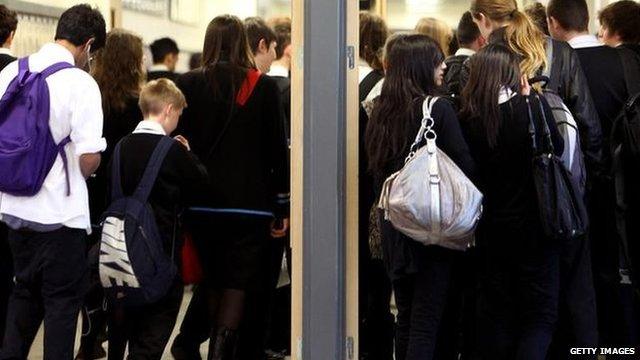'Better outcomes' for Scottish school leavers
- Published

More children in Scotland are leaving school to go into work, education and training than ever before, official statistics show.
The figures revealed 91.7% of school leavers were in a "positive destination" in March 2015, up 1.3% since 2014.
But those leaving with no qualifications increased by 0.2%.
The findings were part of a range of education figures published by Scotland's Chief Statistician.
They also found the number of pupils registered for free school meals had increased from 49.8% in 2014 to 56.6% in 2015.
The rise was attributed to the extension of free school meals in January 2015 for all P1 and P3 pupils - with 80% of children in this age group now registered for a free school meal.
PE provision in both primary and secondary schools also improved with 98% of schools meeting the target of two-hours per week, an increase of 2% on 2014.

ANALYSIS
How easy are the annual Scottish schools stats to understand?

BBC Scotland data journalist Marc Ellison delved into the 34-page report of dense data and attempted to tackle a number of questions including;
How many sources do the stats come from?
Why does government issues such data on a single day?
What do the school leavers stats not reveal?
And which local authority areas failed to hit the PE target?

The statistics, external used data from the Scottish Qualifications Authority, Skill Development Scotland's School Leaver Destination Survey and the latest Healthy Living Survey.
The number of school leavers attaining a qualification at SCQF level 6 or 7 increased from 55.8% in 2011/12 and 2012/13 to 58.8% for 2013/14.
Those leaving with no qualifications at or above SCQF level 3 increased slightly from 1.5% in 2012/13 to 1.7% for 2013/14.
Looked after children continued to have lower levels of attainment, but the gap has reduced during the last three years.
Education Secretary Angela Constance said the figures were encouraging, but there was still room for improvement.
She said: "There is a small number of young people leaving school without qualifications, although an increasing percentage are going onto college and employment.
"School leavers from disadvantaged areas are improving faster, but there is still a gap between those from the most and least deprived areas and I am determined to tackle this."
Attainment gap
Larry Flanagan, general secretary of the EIS teaching union, also welcomed the figures but said more needed to be done to help those from poorer backgrounds.
He said: "Poverty continues to have a negative impact on the education and life chances of too many young people across Scotland and the attainment gap between Scotland's most and least deprived pupils continues to be a huge challenge that society must tackle.
"Measures that are already being taken, including the extension of free school meals to more young people and the launch of the Scottish Attainment Challenge and the Scottish Attainment Fund, have been very positive and welcome steps, but more must be done in terms of increased investment in schools, resources and staffing to ensure that all young people receive the support and opportunities that they deserve."
Opposition parties also said more needs to be done to bridge the attainment gap.
Labour's education spokesman Iain Gray said: "The attainment gap still persists - these statistics show that the poorest 20% are still half as likely as the wealthiest 20% to leave school with one or more Highers.
"That isn't nearly good enough, and again begs the question as to why Nicola Sturgeon, after eight years in power, is just realising now that this is a problem.
"Labour will close the attainment gap with targeted intervention paid for by a 50p top rate of tax.
Liberal Democrat education spokesman Liam McArthur said Scotland's attainment gap would not be closed "unless bold action is taken".
He said: "Four out of 10 pupils from Scotland's most deprived backgrounds leave school with one Higher or more compared to eight out of 10 from Scotland's least deprived backgrounds.
"Whilst there have been steady improvements in passes by pupils from the poorest backgrounds, there has been near corresponding improvements by pupils from better-off backgrounds."
And Conservative young people spokeswoman Liz Smith also said the attainment gap remains too wide.
She said: "We still have a situation where 15% of young people from the most deprived backgrounds leave school to go to absolutely nothing.
"And of course, the biggest concern remains the fact that literacy and numeracy rates fall between the middle years of primary school and the early years of secondary school with significant implications for the persistence of the attainment gap.
"This has to change, and the Scottish government has to be prepared to pursue the radical measures necessary to make that change."